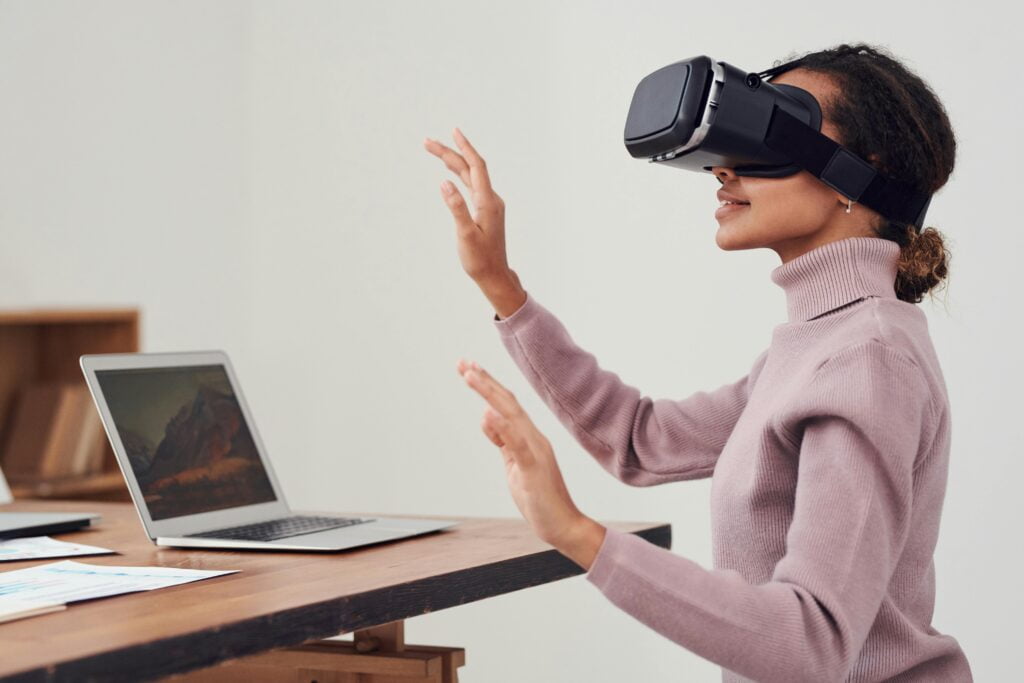- The future of technology is virtual reality

Many of us associate virtual reality (VR) with science fiction movies like “Minority Report.” The reality is that modern technology actually becomes part of our everyday existence. Virtual reality is here to stay in the fields of video gaming, medical, and education. However, precisely what is it?
Virtual reality: What is it?
A computer-generated environment known as virtual reality (VR) gives users the impression that they are fully immersed in their surroundings by simulating real-world scenes and objects. A virtual reality headset, helmet, or other equipment is used to view this environment. Virtual reality (VR) enables us to learn how to operate on hearts, play video games as if we were the characters, and enhance the standard of sports training to maximize performance.
Despite the fact that this seems incredibly futuristic, its roots are older than we may realize. In fact, a lot of people believe that the Sensorama, a machine with an integrated seat that played 3D movies, released aromas, and produced vibrations to enhance the experience, was among the first virtual reality gadgets. The invention first appeared in the middle of the 1950s. In the years that followed, advancements in software and technology brought to a gradual evolution in interface design as well as in devices.
Augmented Reality Distinctions
Even though virtual reality is a relatively new technology, many people are still uninformed about it. Additionally, it’s not uncommon to mix up the terms augmented reality with virtual reality.
The primary distinction between the two is that virtual reality creates the environment in which we are immersed via a particular headgear. It’s completely immersive, with everything we see existing within a synthetic environment created by music, visuals, and other elements. However, in augmented reality (AR), objects, images, and the like are placed within our own environment as a framework. Since everything we see is in a real setting, wearing a headset might not be strictly necessary. Pokémon Go is the most obvious and popular example of this idea.
But there’s also mixed reality, which combines the two worlds. This hybrid technology makes it possible, for example, to perceive virtual objects in the real world and generate an experience in which the physical and the digital are nearly indistinguishable.
Principal Uses for Virtual Reality
That concludes our discussion of the theory that looks ahead. Which industries are utilizing virtual reality technology at the moment? Architecture, education, culture, and medicine are a few fields that have already benefited from this technology. With the use of virtual reality, we may traverse boundaries that would otherwise be unthinkable, such as guided museum visits and muscle dissection.
Virtual reality’s future
One of the technologies with the biggest development potential is virtual reality. The newest predictions from IDC Research (2018) state that over the next four years, investment in VR and AR would increase 21 times, reaching 15.5 billion euros by 2022. Additionally, by 2019, businesses will spend more in this sector than in the consumer sector due to the importance of both technologies to their digital transformation strategies. Therefore, it is anticipated that more than half of the bigger European enterprises would have a VR and RA strategy by 2020.
The market today demands more affordable applications that cater to consumers’ needs beyond marketing, tourism, or leisure. To prevent errors like clipping, which gives the impression that some solid objects can pass through, virtual interfaces also need to be enhanced. Alternatively, to lessen the negative effects that virtual reality has on humans, such as motion sickness, which is a dizziness brought on by the mismatch between our body’s movements and what we observe in the virtual world.
The major IT companies are already working on developing headsets that support high definition viewing and do not require cords. Virtual reality headsets with 8K screens and significantly more powerful processors are being developed. There is even discussion about integrating artificial intelligence over the next few years. The most recent 5G standard may also offer some quite intriguing possibilities for how VR can develop. Large user communities and more gadgets will be able to connect thanks to this standard. Furthermore, customers will be able to get images in real time, virtually as if they were seeing them with their own eyes, because to its very undetectable latency.
This implies that science fiction is no longer applicable to virtual reality. It is a part of the present and will drive innovations that will influence the future in the years to come.







